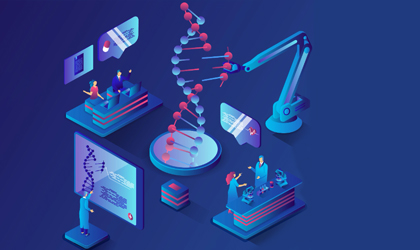
Biotechnology uses living cells to develop or manipulate products for specific purposes, such as genetically modified foods. Biotechnology is thus linked to genetic engineering and emerged as a field in its own right at the beginning of the 20th century in the food industry, which was later joined by other sectors such as medicine and the environment.
Today, the five branches into which modern biotechnology is divided — human, environmental, industrial, animal and plant — help us fight hunger and disease, produce more safely, cleanly and efficiently, reduce our ecological footprint and save energy. All of this has excited stock markets like Wall Street, where biotech was one of the most profitable sectors of the NASDAQ Composite index in 2019.
People have been harnessing biological processes to improve their quality of life for some 10,000 years, beginning with the first agricultural communities. Approximately 6,000 years ago, humans began to tap the biological processes of microorganisms in order to make bread, alcoholic beverages, and cheese and to preserve dairy products. But such processes are not what is meant today by biotechnology, a term first widely applied to the molecular and cellular technologies that began to emerge in the 1960s and ’70s. A fledgling “biotech” industry began to coalesce in the mid- to late 1970s, led by Genentech, a pharmaceutical company established in 1976 by Robert A. Swanson and Herbert W. Boyer to commercialize the recombinant DNA technology pioneered by Boyer, Paul Berg, and Stanley N. Cohen. Early companies such as Genentech, Amgen, Biogen, Cetus, and Genex began by manufacturing genetically engineered substances primarily for medical and environmental uses.
The use and commercialization of modern biotechnology often fall into four main fields: environment, medicine, industry and agriculture.
The aim of environmental biotechnology is to develop sustainable environmental practices that reduce pollution and waste. The following are examples of environmental biotech:
Medical biotechnology, also known as biopharma, aims to fight and prevent disease and improve healthcare. Biotechnology and biomedical research are the basis of the modern pharmaceutical industry.
Uses include the following:
Stem cell research, Gene therapies, 3D printing or growing of organs and bones in labs and MRNA vaccines, monoclonal antibody treatments and research for COVID-19.
Industrial biotechnology involves using microorganisms to produce industrial goods. Examples include the following:
Agricultural biotechnology genetically engineers plants and animals to produce more efficient agriculture, increase nutritional value and reduce food insecurity. Some examples of agricultural biotechnology are the following:
Drought-resistant crops, Minimal space-resilient crops, Meat grown in labs or using 3D printers, Gluten-free grains, Nutrient supplementation